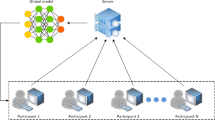Abstract
The rapid development of machine learning and wireless communication is creating a new paradigm for future networks, namely edge-intelligent networks. Specifically, data generated by terminal devices is processed via machine learning at the edge of wireless networks, but not at the cloud. Owing to the growing concern for privacy information sharing, federated learning, as a new branch of machine learning, is appealing in edge-intelligent networks. For federated learning, the wireless transmission capabilities under practical conditions, e.g., imperfect channel state information (CSI), have a great impact on the accuracy of global aggregation of local model updates. Therefore, it is very important to enhance the robustness of communication for federated learning. In order to realize robust communication in the presence of channel uncertainty, we propose a robust federated learning algorithm for edge-intelligent networks, including device selection, transmit power allocation, and receive beamforming. Simulation results validate the robustness and effectiveness of the proposed robust federated learning algorithm in edge-intelligent networks.
Similar content being viewed by others
References
Mao Y, You C, Zhang J, et al. A survey on mobile edge computing: the communication perspective. IEEE Commun Surv Tut, 2017, 19: 2322–2358
Chen X, Qi Q. Convergence of Energy, Computation and Communication in B5G Cellular Internet of Things. Berlin: Springer, 2020
Chen X, Ng D W K, Yu W, et al. Massive access for 5G and beyond. IEEE J Sel Areas Commun, 2021, 39: 615–637
Wang K H, Xiong Z H, Chen L, et al. Joint time delay and energy optimization with intelligent overclocking in edge computing. Sci China Inf Sci, 2020, 63: 140313
Zhao Z, Feng C, Yang H H, et al. Federated-learning-enabled intelligent fog radio access networks: fundamental theory, key techniques, and future trends. IEEE Wireless Commun, 2020, 27: 22–28
McMahan B, Moore E, Ramage D, et al. Communication-efficient learning of deep networks from decentralized data. In: Proceedings of the 20th International Conference on Artificial Intelligence and Statistics, 2017. 54: 1273–1282
Yang H H, Liu Z, Quek T Q S, et al. Scheduling policies for federated learning in wireless networks. IEEE Trans Commun, 2020, 68: 317–333
Chen L, Zhao N, Chen Y, et al. Communicating or computing over the MAC: function-centric wireless networks. IEEE Trans Commun, 2019, 67: 6127–6138
Yang K, Jiang T, Shi Y, et al. Federated learning via over-the-air computation. IEEE Trans Wireless Commun, 2020, 19: 2022–2035
Amiri M M, Gunduz D. Machine learning at the wireless edge: distributed stochastic gradient descent over-the-air. IEEE Trans Signal Process, 2020, 68: 2155–2169
Amiri M M, Gunduz D. Federated learning over wireless fading channels. IEEE Trans Wireless Commun, 2020, 19: 3546–3557
Zhu G, Wang Y, Huang K. Broadband analog aggregation for low-latency federated edge learning. IEEE Trans Wireless Commun, 2020, 19: 491–506
Zhu G, Du Y, Gunduz D, et al. One-bit over-the-air aggregation for communication-efficient federated edge learning: design and convergence analysis. IEEE Trans Wireless Commun, 2021, 20: 2120–2135
Yang H H, Arafa A, Quek T Q S, et al. Age-based scheduling policy for federated learning in mobile edge networks. In: Proceedings of International Conference on Acoustics, Speech, and Signal Processing (ICASSP), Barcelona, 2020. 1–5
Ang F, Chen L, Zhao N, et al. Robust federated learning with noisy communication. IEEE Trans Commun, 2020, 68: 3452–3464
Keskar N S, Mudigere D, Nocedal J, et al. On large-batch training for deep learning: generalization gap and sharp minima. In: Proceedings of International Conference on Learning Representations (ICLR), 2017
Li C, Wang J, Zheng F C, et al. Overhearing-based co-operation for two-cell network with asymmetric uplink-downlink traffics. IEEE Trans Signal Inf Process over Networks, 2016, 2: 350–361
Wang J H, Palomar D P. Worst-case robust MIMO transmission with imperfect channel knowledge. IEEE Trans Signal Process, 2009, 57: 3086–3100
Qi Q, Chen X, Ng D W K. Robust beamforming for NOMA-based cellular massive IoT with SWIPT. IEEE Trans Signal Process, 2020, 68: 211–224
Boyd S, Vandenberghe L. Convex Optimization. Cambridge: Cambridge University Press, 2004
Qi Q, Chen X, Zhong C, et al. Integrated sensing, computation and communication in B5G cellular Internet of Things. IEEE Trans Wireless Commun, 2021, 20: 332–344
Bezdek J C, Hathaway R J. Convergence of alternating optimization. Neural Paral Sci Comput, 2003, 11: 351–368
Both J W. On the rate of convergence of alternating minimization for non-smooth non-strongly convex optimization in Banach spaces. 2019. ArXiv:1911.00404
Ben-Tal A, Nemirovski A. Lectures on Modern Convex Optimization: Analysis, Algorithms, and Engineering Applications. Philadelphia: SIAM, 2001
Luo Z Q, Sidiropoulos N D, Tseng P, et al. Approximation bounds for quadratic optimization with homogeneous quadratic constraints. SIAM J Opt, 2007, 18: 1–28
Shi Y, Cheng J, Zhang J, et al. Smoothed lp-minimization for green cloud-RAN with user admission control. IEEE J Sel Areas Commun, 2016, 34: 1022–1036
Chen X. Massive Access for Cellular Internet of Things Theory and Technique. Berlin: Springer, 2019
Qi Q, Chen X M, Zhong C J, et al. Physical layer security for massive access in cellular Internet of Things. Sci China Inf Sci, 2020, 63: 121301
Acknowledgements
This work was supported by National Key R&D Program of China (Grant No. 2018YFB1801104), National Natural Science Foundation of China (Grant No. 61871344), and Zhejiang Provincial Natural Science Foundation of China (Grant No. LR20F010002).
Author information
Authors and Affiliations
Corresponding author
Rights and permissions
About this article
Cite this article
Gao, Z., Chen, X. & Shao, X. Robust federated learning for edge-intelligent networks. Sci. China Inf. Sci. 65, 132306 (2022). https://doi.org/10.1007/s11432-020-3251-9
Received:
Revised:
Accepted:
Published:
DOI: https://doi.org/10.1007/s11432-020-3251-9




